多交叉不连续面的不连续面丰富有限元法
IF 6.9
1区 工程技术
Q1 ENGINEERING, MULTIDISCIPLINARY
Computer Methods in Applied Mechanics and Engineering
Pub Date : 2024-11-09
DOI:10.1016/j.cma.2024.117432
引用次数: 0
摘要
我们扩展了非连续性富集有限元法(DE-FEM),以模拟相交的非连续性,如在多晶材料、多材料楔形问题和分支裂缝中遇到的非连续性。所提出的分层富集函数可在单一公式中捕捉交界处的弱不连续性和强不连续性。本文介绍了对热负荷和机械负荷下的支化裂缝和多晶微结构的若干数值应用,以演示所提出的方法。结果表明,DE-FEM 可以准确捕捉复杂的不连续基元场和梯度场,其收敛速度可与使用拟合网格的标准 FEM 相媲美。配备了所提议的结点富集函数的 DE-FEM 的主要优势在于,该方法能够使用与不连续面完全解耦的网格对相交的不连续面进行建模,并能稳健地再现跨不连续面的正确位移和应变跃迁,这一点已通过补丁测试得到证明。因此,这项工作凸显了 DE-FEM 应用于以存在多个相交不连续面为特征的问题的潜力,是传统 FEM 和扩展/广义有限元 (X/GFEM) 方法的有效替代方法。本文章由计算机程序翻译,如有差异,请以英文原文为准。

The discontinuity-enriched finite element method for multiple intersecting discontinuities
We extend the Discontinuity-Enriched Finite Element Method (DE-FEM) to simulate intersecting discontinuities, such as those encountered in polycrystalline materials, multi-material wedge problems, and branched cracks. The proposed hierarchical enrichment functions capture weak and strong discontinuities at junctions within a single formulation. Several numerical applications to branched cracks and polycrystalline microstructures under both thermal and mechanical loads are presented to demonstrate the proposed method. Results indicate that DE-FEM can accurately capture complex discontinuous primal and gradient fields and attain convergence rates comparable to those of standard FEM using fitted meshes. The main advantages of DE-FEM equipped with the proposed junction enrichment functions lie in the method’s ability to model intersecting discontinuities using meshes that are completely decoupled from them and its robustness in reproducing correct displacement and strain jumps across them, as demonstrated by a patch test. This work thus highlights the potential of DE-FEM for applications to problems characterized by the presence of multiple intersecting discontinuities, posing a valid alternative to traditional FEM and eXtended/Generalized Finite Element (X/GFEM) Methods.
求助全文
通过发布文献求助,成功后即可免费获取论文全文。
去求助
来源期刊
CiteScore
12.70
自引率
15.30%
发文量
719
审稿时长
44 days
期刊介绍:
Computer Methods in Applied Mechanics and Engineering stands as a cornerstone in the realm of computational science and engineering. With a history spanning over five decades, the journal has been a key platform for disseminating papers on advanced mathematical modeling and numerical solutions. Interdisciplinary in nature, these contributions encompass mechanics, mathematics, computer science, and various scientific disciplines. The journal welcomes a broad range of computational methods addressing the simulation, analysis, and design of complex physical problems, making it a vital resource for researchers in the field.

 求助内容:
求助内容: 应助结果提醒方式:
应助结果提醒方式:


